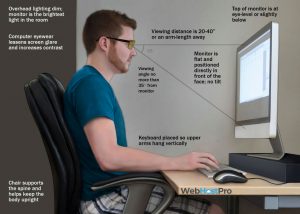Proper computer posture – Web Host Pro Blog – Web Hosting, VPS, CPanel, dedicated servers


Ten quick tips for sitting better
Serious about maintaining better posture on the computer? Then keep reading for more in-depth help.
Maintaining good posture while using a computer is crucial for preventing discomfort and long-term health issues. Here are some tips to help you achieve this:
Implementing these ergonomic guidelines will help maintain good posture and minimize the risk of discomfort or injury in the long run. Remember, your workspace should fit you, not the other way around.


